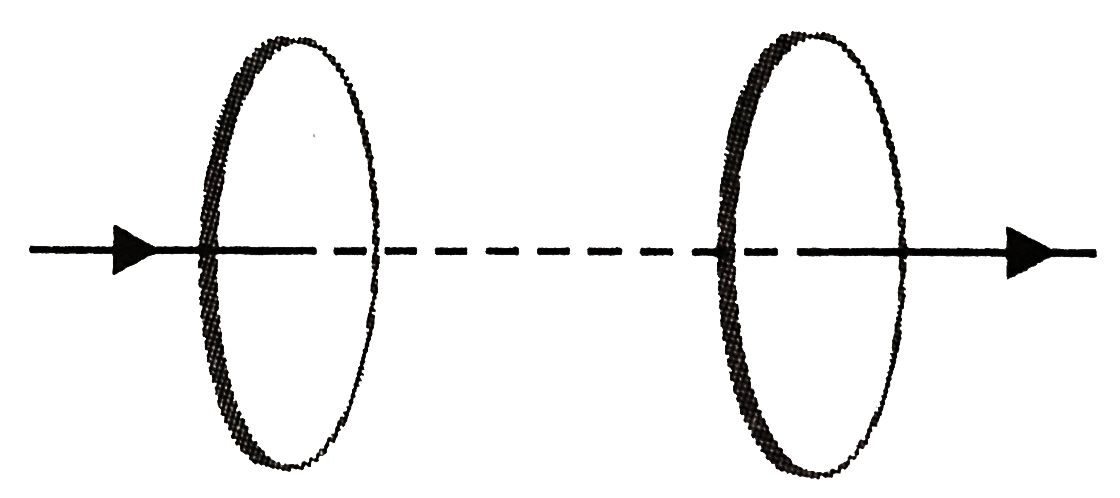A capacitor, made of two parallel plates each of plate area A and separation d, is being charged by an external ac socurce. Show that the displacement current inside the same as the current charging the capacitor.
To show that the displacement current inside a capacitor is the same as the current charging the capacitor, we can follow these steps:
Step 1: Understand the setup
We have a capacitor made of two parallel plates, each with an area A and separated by a distance d. An alternating current (AC) source is charging the capacitor, which generates an electric field between the plates.
Step 2: Write the expression for voltage
The voltage across the capacitor due to the AC source can be expressed as:
V(t)=E0sin(ωt)
where E0 is the peak voltage and ω is the angular frequency of the AC source.
Step 3: Relate charge and voltage
The charge Q on the capacitor is given by the formula:
Q=C⋅V
where C is the capacitance of the capacitor. Substituting the expression for V(t):
Q(t)=C⋅E0sin(ωt)
Step 4: Differentiate charge with respect to time
To find the current I charging the capacitor, we differentiate Q(t) with respect to time t:
I=dQdt=ddt(C⋅E0sin(ωt))
Using the chain rule, we get:
I=C⋅E0⋅ωcos(ωt)
Step 5: Define the displacement current
The displacement current Id is defined as:
Id=ϵ0dΦdt
where Φ is the electric flux. The electric field E between the plates of the capacitor can be expressed as:
E=Qϵ0A
Thus, the electric flux Φ is:
Φ=E⋅A=Qϵ0
Step 6: Differentiate the electric flux
Now, we differentiate Φ with respect to time:
Id=ϵ0ddt(Qϵ0)=dQdt
Since we already found dQdt=I, we have:
Id=I
Conclusion
Thus, we have shown that the displacement current Id is equal to the current I charging the capacitor:
Id=I
We have a capacitor made of two parallel plates, each with an area A and separated by a distance d. An alternating current (AC) source is charging the capacitor, which generates an electric field between the plates.
The voltage across the capacitor due to the AC source can be expressed as:
V(t)=E0sin(ωt)
where E0 is the peak voltage and ω is the angular frequency of the AC source.
The charge Q on the capacitor is given by the formula:
Q=C⋅V
where C is the capacitance of the capacitor. Substituting the expression for V(t):
Q(t)=C⋅E0sin(ωt)
To find the current I charging the capacitor, we differentiate Q(t) with respect to time t:
I=dQdt=ddt(C⋅E0sin(ωt))
Using the chain rule, we get:
I=C⋅E0⋅ωcos(ωt)
The displacement current Id is defined as:
Id=ϵ0dΦdt
where Φ is the electric flux. The electric field E between the plates of the capacitor can be expressed as:
E=Qϵ0A
Thus, the electric flux Φ is:
Φ=E⋅A=Qϵ0
Now, we differentiate Φ with respect to time:
Id=ϵ0ddt(Qϵ0)=dQdt
Since we already found dQdt=I, we have:
Id=I
Thus, we have shown that the displacement current Id is equal to the current I charging the capacitor:
Id=I
Topper's Solved these Questions
Similar Questions
Knowledge Check
A capacitor made of two circular plates each of radius 12 cm and separated by 5 cm. The capacitor is being charged by an external source. The charging current is constant and equal to 0.15 A. The capacitance of the parallel plate capacitor is
 A40 pFB45 pFC70 pFD80 pF
A40 pFB45 pFC70 pFD80 pF
Imagine a light planet revolving around a very massive star in a circular orbit of radius r with direction T. On what power of r, will the square of time period depends if the gravitational force of attraction between the planet and the star is proportional to r−5/2 .
View SolutionFig. shows a capacitor made of two circular plates each of radius 12 cm and separated by 5.0mm. The capacitor is being charged by an external source (not shown in the figure). The charging current is constant and equal to 0.15A.
(a) Calculate the capacitance and the rate of change of potential difference between the plates.
(b) Obtain the displacement current across the plates.
(c) Is Kirchhoff's first rule valid at each plate of the capacitor ? Explain.

View SolutionFigure shows a capacitor made of two circular plates each of radius 12cm, and separated by 5.0cm. the capacitor is being charged by an external source (not shown in the figure). The charging current is constant and equal to 0.15A
(a) Calcuate the capacitance and the rate of change of potential difference between the plates
(b) Obtain the displacement current across the plates
(c) Is kirchhoff's first rule(junction rule) vaild at each plate of the capacitor ? Explain.
 .
.
View SolutionFind out the capacitance of parallel plate capacitor of plate area A and plate separation d.
View SolutionThe charging current for a capacitor is 1 A, then the displacement current is
View SolutionA parallel plate capacitor, with plate area A and plate separation d, is filled with a dielectric slabe as shown. What is the capacitance of the arrangement ?
View SolutionDisplacement current is maximum during charging of capacitor. When charge on the capacitor is
View Solution
